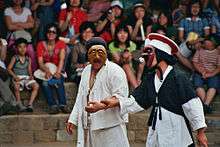Hahoe byeolsingut talnori
Hahoe byeolsingut talnori (하회별신굿탈놀이, 河回別神굿탈놀이) or "Hahoe special ritual drama to the gods" is a Korean masked dance-drama performed every three, five, or ten years at the request of the village deity in Hahoe, Andong, North Gyeongsang Province. The village is a UNESCO World Heritage Site, the dance-drama an Important Intangible Cultural Property, and a collection of thirteen (13) masks are a National Treasure. The ritual shares some of the major themes of Korean masked drama and Korean shamanism, namely satire and the ridicule of apostate Buddhist priests and the nobility.[1][2][3]

Ritual
The annual village fertility rites known as dong-je include the reading of charms and prayers, but no masked drama.[1] The special ritual of byeolsingut talnori or pyŏlsin kut-nori is performed irregularly at the end of December and early January in order to appease the deity Seonangsin. It has a five-hundred year history and has been designated an Important Intangible Cultural Property (No. 69, designated 1980).[1][4] After a period of purification and confinement, there is a procession that is followed by the masked dance-drama, in eight main episodes (madang):[4]
- (1) Shaman episode (Mudong madang)
- (2) Lion episode (Juji madang)
- (3) Butcher's episode (Baekjeong madang)
- (4) Old widow's episode (Halmi madang)
- (5) Apostate monk’s episode (Pagyeseong madang)
- (6) Nobleman and scholar’s episode (Yangban and Seonbi madang)
- (7) Wedding ceremony episode (Holrye madang)
- (8) Wedding night’s episode (Sinbang madang)
The dance-drama, with musical accompaniment, exhibits considerable ribaldry, with the lions fighting and simulating intercourse; the butcher acting out the sacrifice of a bull before try to sell its heart and testicles; the old widow at the loom sadly singing of her solitary life; the lecherous, apostate monk stumbling upon Pune, a flirtatious young woman or dancing girl, while she micturates and, aroused, sniffing the ground before running off with her; the nobleman and scholar attempting to win Pune's favours by boasting of their good-breeding and learning, while she flirts with each in turn by killing his lice, before the proceedings are interrupted by a tax-collector; followed by the reenactment of a wedding ceremony and the ensuing wedding night that is so lifelike that minors and women are not allowed to watch.[1]
Masks
Eleven masks (11) from Hahoe and two from the neighbouring village of Byeongsan have been designated a National Treasure (No. 121, designated 1964).[5] While festival masks are typically made from a gourd or paper, and are often burned after the festivities are over, these masks are of painted alder wood, with movable jaws separately attached with a cord. The eleven surviving Hahoe masks – others are believed lost, including that of the bachelor (Chonggak) – include the two lions (Juji), butcher (Baekjeong), old widow (Halmi), the depraved monk (Chung), flirtatious young woman (Pune), nobleman (Yangban), scholar (Seonbi), bride (Gaksi), meddling low-class merchant (Choraengi), and fool (Imae).[5][6] The masks are now to be found in the Hahoe Mask Museum.[6]
See also
- Important Intangible Cultural Properties of Korea
- National Treasures of South Korea
- Korean shamanism
- List of World Heritage Sites in South Korea
- Intangible cultural heritage
References
- NRICP, ed. (1987). "The Folkloristic Background of Korean Masked Dance-Drama". International Symposium on the Conservation and Restoration of Cultural Property: Masked Performances in Asia (1986 Symposium). Tokyo Research Institute of Cultural Properties. pp. 183–190.
- "Heritage Information – General Search (search term: hahoe)". Cultural Heritage Administration. Retrieved 3 May 2012.
- "Historic Villages of Korea: Hahoe and Yangdong". UNESCO. Retrieved 3 May 2012.
- "Heritage Information – General Search – Important Intangible Cultural Property 69". Cultural Heritage Administration. Retrieved 3 May 2012.
- "Heritage Information – General Search – National Treasure 121". Cultural Heritage Administration. Retrieved 3 May 2012.
- "Hahoe Mask Museum". Hahoe Mask Museum. Retrieved 3 May 2012.